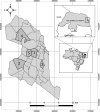Dengue virus in Aedes aegypti and Aedes albopictus in urban areas in the state of Rio Grande do Norte, Brazil: Importance of virological and entomological surveillance
- PMID: 29534105
- PMCID: PMC5849307
- DOI: 10.1371/journal.pone.0194108
Dengue virus in Aedes aegypti and Aedes albopictus in urban areas in the state of Rio Grande do Norte, Brazil: Importance of virological and entomological surveillance
Abstract
Background: Vector control remains the sole effective method to prevent dengue virus (DENV) transmission, although a vaccine for dengue has recently become available and testing of its efficacy and coverage is being performed in multiple places. Entomological surveillance is a key factor in alerting authorities to possible outbreaks, but until now natural DENV infection of mosquito populations has been scarcely used as an early warning system to monitor fluctuating prevalence of infected mosquitoes. The purpose of this study was to determine the burden of adult and larval/pupae of Aedes aegypti and Aedes albopictus with DENV in urban areas in the state of Rio Grande do Norte, Brazil.
Methodology/principal findings: Immature insect forms (larvae and pupae) were collected from April 2011 to March 2012, whereas the collection of adults was conducted along 3 years: May 2011 to April 2014. Total RNAs of the samples were extracted and the nested reverse transcriptase PCR assay for detecting and typing DENV was performed. Of the 1333 immature insects collected during the study period, 1186 (89%) were A. aegypti and 147 (11%) A. albopictus. DENV-4 was identified in pools of A. aegypti larvae. The rate of DENV infection in immature A. aegypti was expressed as MIR = 3.37. DENV wasnot detected in immature A. albopictus. A total of 1360 adult female mosquitoes of the Aedes genus were captured from May 2011 to April 2014. Of this total, 1293 were A. aegypti (95%) and 67 were A. albopictus (5%). From the 130 pools studied, 27 (20.7%) were positive for DENV. DENV-1 was identified in 2/27 (7.4%) pools; 1of A. albopictus and 1 of A. aegypti. DENV-2 was identified in only 1/27 (3.7%) A. aegypti pools. DENV-4 was the most prevalent, identified in 24/27 (88.8%) of the positive pools, with 19 being of A. aegypti and 5 of A. albopictus pools. The minimum infection rate for adults of the Aedes genus was 19.8, considering both A. aegypti and A. albopictus.
Conclusions/significance: This work represents the most complete study to date on the interaction between dengue viruses and Aedes mosquitoes in the State of Rio Grande do Norte, and raises important questions about a possible role of A. albopictus in the transmission of dengue virus in Brazil.
Conflict of interest statement
Figures

Similar articles
-
A Comprehensive Entomological, Serological and Molecular Study of 2013 Dengue Outbreak of Swat, Khyber Pakhtunkhwa, Pakistan.PLoS One. 2016 Feb 5;11(2):e0147416. doi: 10.1371/journal.pone.0147416. eCollection 2016. PLoS One. 2016. PMID: 26848847 Free PMC article.
-
Occurrence of natural vertical transmission of dengue-2 and dengue-3 viruses in Aedes aegypti and Aedes albopictus in Fortaleza, Ceará, Brazil.PLoS One. 2012;7(7):e41386. doi: 10.1371/journal.pone.0041386. Epub 2012 Jul 25. PLoS One. 2012. PMID: 22848479 Free PMC article.
-
Screening of dengue virus in field-caught Aedes aegypti and Aedes albopictus (Diptera: Culicidae) by one-step SYBR green-based reverse transcriptase-polymerase chain reaction assay during 2004-2007 in Southern Taiwan.Vector Borne Zoonotic Dis. 2010 Dec;10(10):1017-25. doi: 10.1089/vbz.2008.0069. Epub 2010 May 18. Vector Borne Zoonotic Dis. 2010. PMID: 21128850
-
[Aedes albopictus, vector of chikungunya and dengue viruses in Reunion Island: biology and control].Parasite. 2008 Mar;15(1):3-13. doi: 10.1051/parasite/2008151003. Parasite. 2008. PMID: 18416242 Review. French.
-
Consequences of the expanding global distribution of Aedes albopictus for dengue virus transmission.PLoS Negl Trop Dis. 2010 May 25;4(5):e646. doi: 10.1371/journal.pntd.0000646. PLoS Negl Trop Dis. 2010. PMID: 20520794 Free PMC article. Review.
Cited by
-
High voltage-gated sodium channel gene diversity in Aedes albopictus across Brazil.Sci Rep. 2025 Jul 1;15(1):20832. doi: 10.1038/s41598-025-08989-x. Sci Rep. 2025. PMID: 40596556 Free PMC article.
-
Natural vertical transmission of dengue virus in Latin America and the Caribbean: highlighting its detection limitations and potential significance.Parasit Vectors. 2023 Nov 28;16(1):442. doi: 10.1186/s13071-023-06043-1. Parasit Vectors. 2023. PMID: 38017450 Free PMC article. Review.
-
Entomo-Virological Aedes aegypti Surveillance Applied for Prediction of Dengue Transmission: A Spatio-Temporal Modeling Study.Pathogens. 2022 Dec 20;12(1):4. doi: 10.3390/pathogens12010004. Pathogens. 2022. PMID: 36678352 Free PMC article.
-
First Record of Natural Transovarial Transmission of Dengue Virus in Aedes albopictus from Cuba.Am J Trop Med Hyg. 2021 Nov 8;106(2):582-584. doi: 10.4269/ajtmh.21-0710. Am J Trop Med Hyg. 2021. PMID: 34749310 Free PMC article.
-
Potential Way to Develop Dengue Virus Detection in Aedes Larvae as an Alternative for Dengue Active Surveillance: A Literature Review.Trop Med Infect Dis. 2024 Mar 11;9(3):60. doi: 10.3390/tropicalmed9030060. Trop Med Infect Dis. 2024. PMID: 38535884 Free PMC article. Review.
References
-
- World Health Organization (WHO). Dengue: Guidelines for diagnosis, treatment, prevention and control. New edition Geneva, Switzerland: 2009. - PubMed
-
- Pierson TC, Diamond MS.Flaviviruses In: Knipe DM, Howley PM. FieldsVirology, 6th ed 2013.
-
- World Health Organization (WHO). Global Strategy for dengue prevention and control, 2012–2020. 2012.
-
- Ramos-Castañeda J, Barreto Dos Santos F, Martínez-Vega R, Galvão de Araujo JM, Joint G, Sarti E.Dengue in Latin America: Systematic Review of Molecular Epidemiological Trends. PLOS Neglected Tropical Diseases. 2017; 9;11(1):e0005224 doi: 10.1371/journal.pntd.0005224 - DOI - PMC - PubMed
Publication types
MeSH terms
LinkOut - more resources
Full Text Sources
Other Literature Sources
Medical
Miscellaneous

